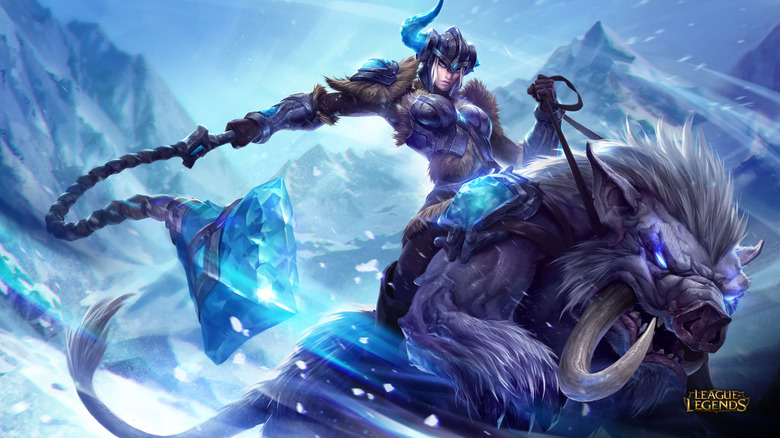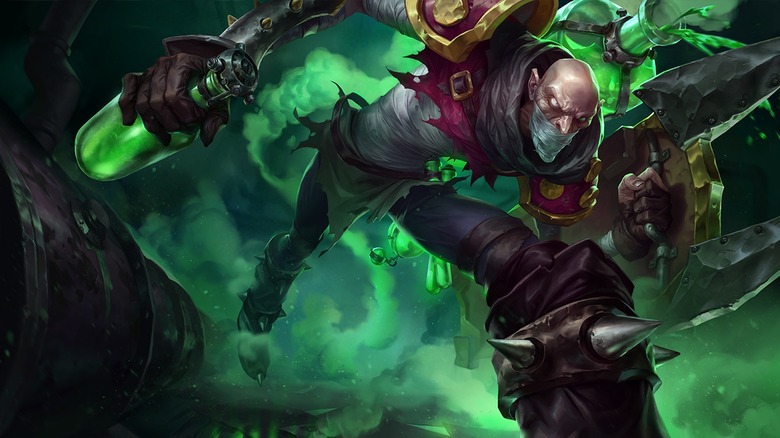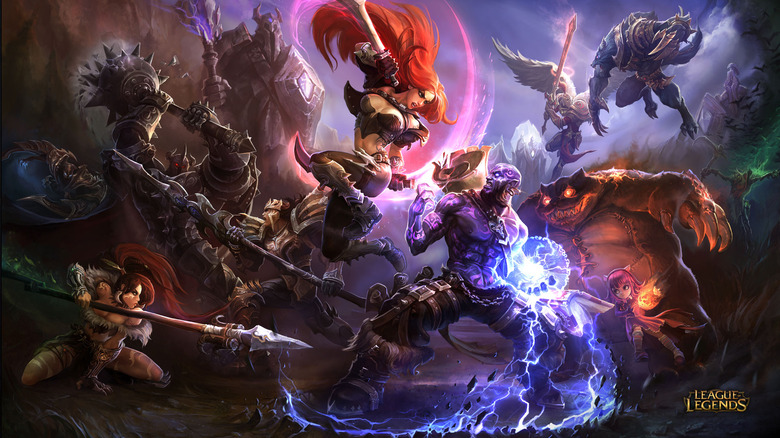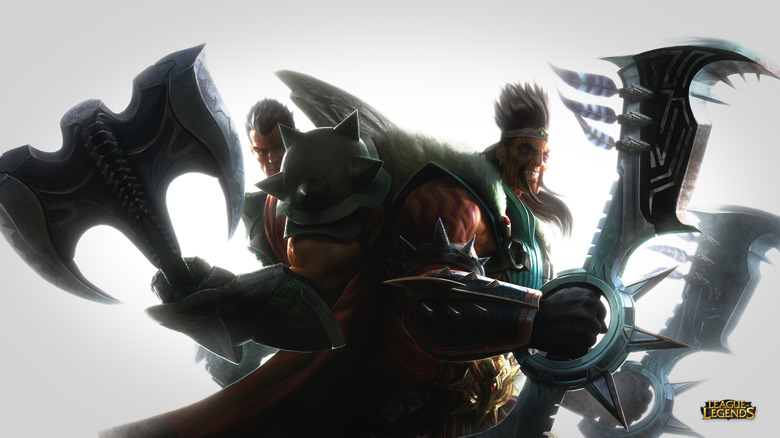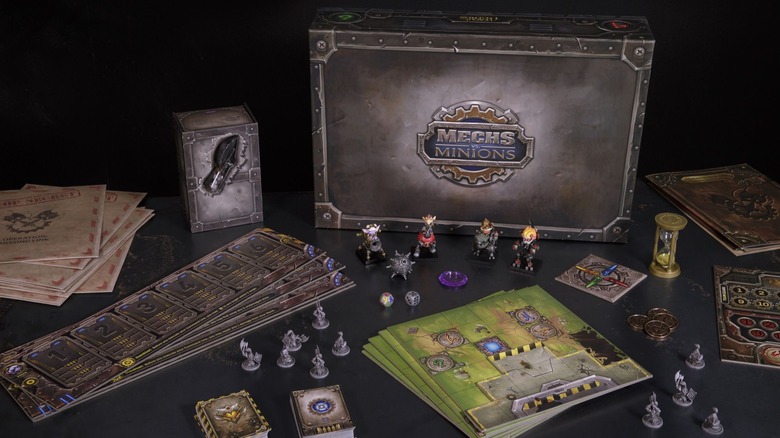The Untold Truth Of League Of Legends
As newer titles grab away many of the headlines, it can be easy to forget some of the old powerhouses. However, don't sleep on League of Legends: it's still going very strong. Riot Games' MOBA continues to draw huge numbers of both pros and casual gamers alike. Venture Beat wrote that, in 2014, League of Legends easily broke the $1 billion mark for revenue. And since then, it's only grown: DblTap writes that, in 2017, LoL broke the $2 billion threshold.
In addition, LoL remains a top eSports contender. College League of Legends tournaments field teams from huge, state universities like the University of Illinois and the University of Maryland, and ESPN even reports that several division one schools are adding eSports programs, with LoL being one of the most highly recruited games.
Let's delve into the depths of Riot's money-maker and dig up just what makes League of Legends such a huge player in the world of gaming.
League of Legends and Dota 2 both share roots in a Warcraft III mod
League of Legends and Valve's Dota 2 are direct rivals, similar to other video game debates like Battlefield vs. Call of Duty or PlayerUnknown's Battlegrounds vs. Fortnite. LoL and Dota 2 actually both stem from the exact same place: a Warcraft III mod called Defense of the Ancients.
The similar play structure of both games can be traced to Defense of the Ancients: kill creeps, push towers, and lay siege to your opponents' base. One of the original developers of the mod is one Steve Feak, who brought in another developer who only went by "IceFrog" to help once the mod started to gain some traction. After Defense of the Ancients caught fire with millions of players, Riot Games recruited Feak and Steve Mescon, who ran a popular fansite for the mod, to front the development of their new game, League of Legends. Not long after, Valve hired IceFrog to transform Defense of the Ancients into their own flagship property, Dota 2.
The rivalry between the two games is not the friendliest, as both communities feel that the other side betrayed them. Cybersport has the story of the entire messy ordeal, and we may never know just what exactly happened during those few years. To this day, however, League of Legends remains a juggernaut in the gaming world.
League of Legends originally had a much longer title
It's odd to think that there was a time when the general gaming public did not really know what a MOBA was, and you really don't have to go back all that far to find the roots of the genre. League of Legends officially released in October of 2009, and it was originally planned that it would go under the much longer and clunkier title League of Legends: Clash of Fates. Not only is that title an uncomfortable mouthful, but the acronym also doesn't really work. Can you imagine typing LoL:CoF whenever you were trying to discuss the game? It seems likely that, even if it had released with that title, the game would have dropped the second half of it before too long.
Even though the original title was not so impressive, Riot had a good idea of what they were planning with LoL well before it was released. Check out this 2008 IGN article on League of Legends: Clash of Fates, which shows off three champions that would later join the fray when the game was released with its snappier moniker.
Singed was most likely the first champion designed (though not one of the first released)
Although League of Legends lacks a true mascot, there are a few characters who are seemingly recognized as the face of the game. Teemo, due to his cuteness and high-level ability to irritate players, has plenty of merchandise. Others might say Akali or Garen could serve as the game's mascot. Early on, however, Riot put its money on a bit of a different pick: Singed, the mad alchemist. He was a featured character early in the game's development, and he actually helped inspire many other champions.
As one of the original champions released during the closed beta, Singed was designed very early on. He did not make it to the open beta until after the first update, however. The alchemist's design helped to bring personality to other champions. In the Art of League of Legends book, the designers discuss that having a large, unique accessory helps bring personality to the characters, and Singed gigantic bottle of poison helped them recognize that fact. Singed's singular detail helped dictate the design of other champions, like Ryze and Dr. Mundo.
League of Legends helped pioneer the free-to-play model for AAA titles
Free-to-play games seem to dominate the landscape of video gaming currently, but it was actually League of Legends that helped push that model into the mainstream, especially for big-budget titles. Riot's approach to F2P may not seem unique now, but it was revolutionary in 2009. Riot Games CEO Brandon Beck spoke with Fortune in an interview: "When Marc [Merrill] and I founded Riot, most gamers were being asked to pay $60 for a traditional game-in-a-box to be played on consoles or PCs." He continues by claiming that the key to a successful F2P model is to still treat the quality of the game like a paid title, and players will be glad to pay for aspects of it. He also says that, since LoL's release, there has been a "revolution" for F2P games.
Just because it's free doesn't mean League of Legends doesn't make any money. The proof of Beck's "revolution" is in the pudding: according to SuperData Research (via DblTap), League of Legends raked in $2.1 billion in 2017. That was the most money of any free-to-play PC title by about half a billion dollars. To put that in perspective, League of Legends brought in more money than Dota 2, World of Tanks, Hearthstone, MapleStory, and Roblox. Combined.
With so many champions, Riot has had to draw from some odd inspirations for characters
League of Legends has over 100 different champions to master. Obviously, some pretty standard archetypes exist in the game: Garen is a valiant knight, Nocturne is a shadowy nightmare, and so on. For some of their other characters, however, Riot has drawn inspiration from popular fantasy stories, real-world fighting masters, and some even more bizarre places.
Aatrox, a soul trapped inside a sword, may seem reminiscent of the bonkers story of the Soul Calibur series. Mike Laygo, senior animator for Riot, actually stated on Reddit that the character's animations and movements were somewhat-based on both Sauron and the Balrog from Lord of the Rings. Fitting, considering Laygo also worked on Lord of the Rings: The Battle for Middle-Earth.
Fiora, known as the "Grand Duelist" and fencer extraordinaire, probably comes from a bit more obscure stock. She seems to have much in common with 14th-Century legend Fiore dei Liberi, a fencing master who authored a fighting manual called The Flower of Battle. His book is one of the world's oldest surviving fencing manuals.
Not every hero comes from a legendary warrior, fictional or otherwise. Yorick, the gravedigger, is an easy reference to Hamlet. Heimerdinger, genius inventor, has taken his name from two genius physicists: Robert Oppenheimer and Erwin Schrodinger. Hell: Teemo, with his giant, stupid, smiling face, is just an anagram of the word "emote."
Moral of the story: screw Teemo.
There are plenty of rare skins that are impossible to get at this point
Since LoL was at the forefront of the free-to-play revolution, it has to make its money in other ways. Once players have picked up their favorite champions, they can unlock all sorts of other cosmetic items for them, including several skins for each one. Some of these skins are simple color shifts, while others completely change every aspect of how the champion looks. Essentially: not every League of Legends skin available in the marketplace is equal.
But there are also the legendary skins: the ones that you cannot pick up in the marketplace. Most of these skins were available in limited quantities near when the game was first released; if you weren't an early backer, you are out of luck. It isn't too tough to find images of the rarest skins out there in LoL, including the "King Rammus" skin that was only made available to players who participated in the closed beta. It transforms the champion Rammus into a dead ringer for Super Mario's nemesis Bowser.
Other impossible to obtain skins include "Young Ryze" and "Black Alistar," which came with preorders of League of Legends, "Silver Kayle," which came with the Collector's Edition, and "PAX Twisted Fate," which was given to attendees of PAX 2009. The only way you can get your hand on these skins is by purchasing an account from someone who already has them.
League of Legends pros can earn huge sums of money (and are usually from Korea)
It can be tough to determine just how much money professional League of Legends players can take in, as their contracts are not quite as public as athletes in traditional professional sports. However, some numbers have gotten out there, and there is a huge amount of money to be had if a player can climb their way to the top of the ladder.
You have to piece some numbers together in order to determine how much the top LoL pros can make, but consistent finishes can take someone into the "comfortable millionaire" range. An eSports article from Red Bull showed that the top ten prize winners from 2016 each brought in over $300,000 in tournament winnings, with Lee "Faker" Sang-hyeok bringing in nearly $900,000. However, those numbers only seems to indicate tournament winnings. A Kotaku source found that Lee was offered multiple contracts by Chinese LoL teams offering him a base pay of at around $200,000, possibly more, per year. An ESPN article interviewed several North American pros and found that their average base salary (which doesn't include streaming revenue or prize money) registers at just over $100,000 per year.
There may be a bit of a cultural barrier to overcome if you want to break into those big earnings. Nine of the ten players in the Red Bull article hail from South Korea.
Several champions also have siblings fighting the fight
Not only did Riot Games create a deep, engaging game with an insanely high skill ceiling, but each of the champions in League of Legends has a deep, engaging story to go with it. They have different motivations for fighting the battle for Runeterra: some righteous, some villainous, and others just plain silly. One fascinating aspect of the champions' relationships lie in just how many siblings are battling it out in LoL.
Some of the sibling pairs in League of Legends fight on the same side of morality. Garen and Lux, for example, are a brother and sister who both fight to defend the kingdom of Demacia against evil. Others are pitted against each other: Kayle and Morgana are both immortal beings who view the other as tyrannical and a threat to existence. Other sibling pairs include Katarina and Cassiopeia, Nasus and Renekton, Darius and Draven, and Jinx and Vi. The last on that list was long speculated due to some of the hints and lore snippets that came out when Jinx was released in October 2013. The fact that Jinx and Vi are sisters was not officially recognized until September 2017, when Riot's design director Greg Street mentioned the relationship in an interview.
Riot created a tabletop game set in the LoL universe
Millions of people playing League of Legends online wasn't enough for Riot Games: they had to invade the tabletop market as well. In October of 2016, they released Mechs vs. Minions, a 2-4 player cooperative board game set in the world of Runeterra. It isn't just the LoL license slapped onto a terrible game, either: at the time of this publication, Board Game Geek's user ratings currently have it at an 8.2 out of 10 rating, good enough for their #24 spot of every tabletop game ever made. It was also nominated for several awards upon its release, including SXSW's Tabletop Game of the Year award and several Golden Geek awards.
Riot's website explains the game has a full campaign and story, where players take control of Heimerdinger, Tristana, Corki, and Ziggs and have to work together to fend off waves of enemies. It is full of miniatures, and is actually fairly inexpensive for all the components that come with it. It also appears to stay pretty true to the League of Legends world, and you can pick up a copy from Riot's online store.
Riot pulled out some obscure dance moves for their different champions
We all know that the champions in League of Legends can dish out some serious damage. Perhaps not as obvious, however, are the fantastic dance moves that each champion possesses. You can make your chosen champion take a break from all the fighting with chat commands like "/joke," "/taunt," and, of course, "/dance."
What's especially great about the "/dance" command are the "Hey, I've seen those moves before!" moments that so many of the champions can elicit. Some of them are more obvious: Warwick, League of Legends' resident werewolf, busts out his best Michael Jackson moves that you yourself have probably tried out at a wedding or two. There are references to old cartoons, like Kog'Maw doing his best impression of Michigan J. Frog, and new cartoons, like Jinx getting down just like Jake the Dog.
Nearly every champion in League of Legends has some sort of reference through their dance. Prepare to do some intense Google Fu if you want to know them all: some of them are really deep cuts. We're talking Volibear's Sam B dance from America's Got Talent deep cuts.



